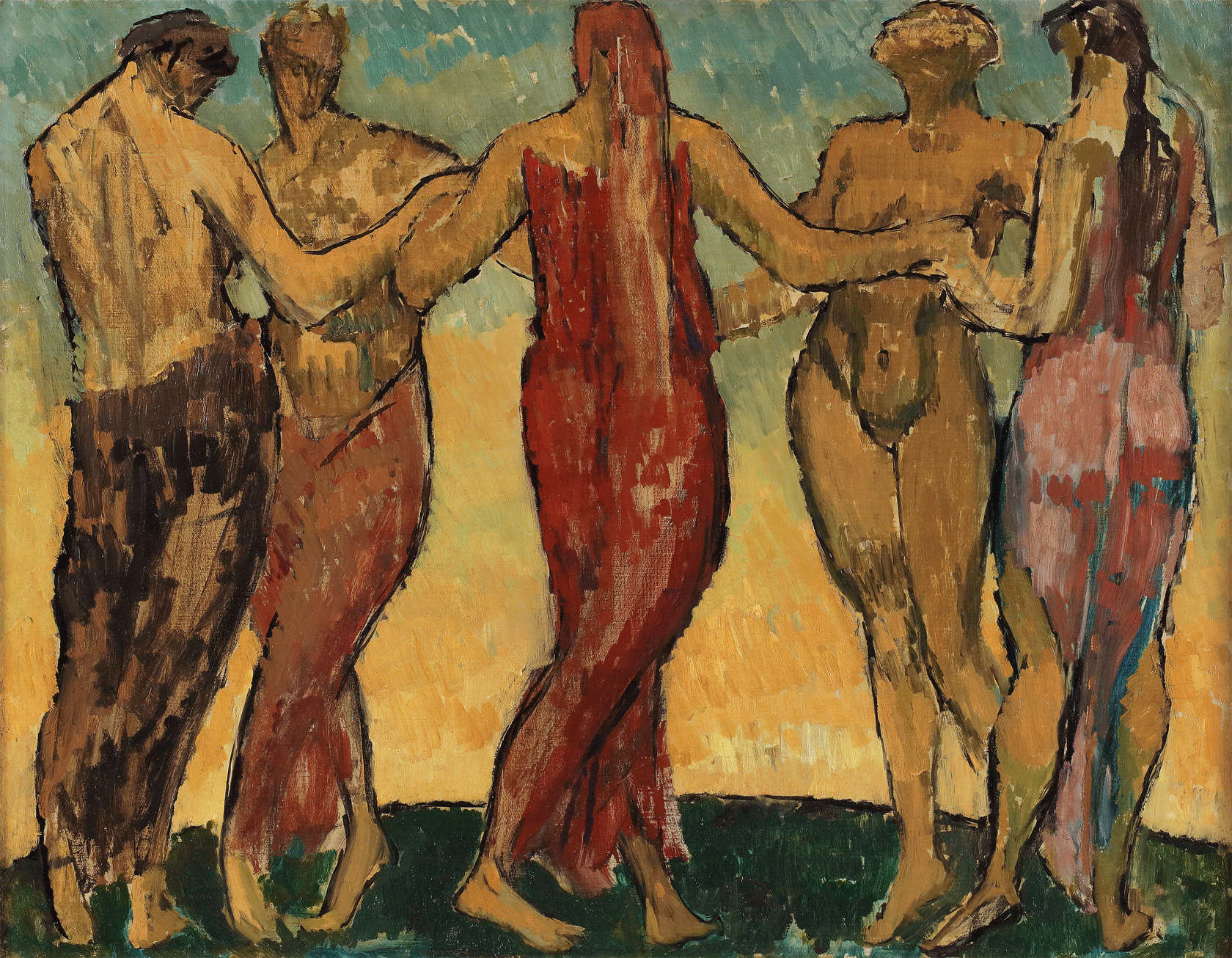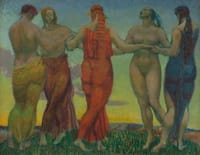Duncan Grant’s Dancers encapsulates a moment of radical transition in British art. Showcased at Roger Fry's seminal Second Post-Impressionist Exhibition, it is one of Britain’s first truly modernist works. In this depiction of five dancing figures, Grant fuses modernist movements such as cubism with his distinctive eye for pattern and design. Acquired directly from Fry’s landmark exhibition, this work has, until recently, remained in the same family's collection since its execution in 1912.
The significance of this painting and its presence at the Second Post-Impressionist Exhibition cannot be overstated. Fry’s curatorial vision was to challenge British taste, which was still largely conservative and rooted in Victorian traditions, by presenting the radical innovations of European figures like Paul Cézanne, Henri Matisse, and Pablo Picasso. The inclusion of Grant’s work in this context positioned him at the forefront of the emerging British modernist movement. His ability to synthesise European avant-garde trends with a uniquely British sensibility helped pave the way for modernism...
Duncan Grant’s Dancers encapsulates a moment of radical transition in British art. Showcased at Roger Fry's seminal Second Post-Impressionist Exhibition, it is one of Britain’s first truly modernist works. In this depiction of five dancing figures, Grant fuses modernist movements such as cubism with his distinctive eye for pattern and design. Acquired directly from Fry’s landmark exhibition, this work has, until recently, remained in the same family's collection since its execution in 1912.
The significance of this painting and its presence at the Second Post-Impressionist Exhibition cannot be overstated. Fry’s curatorial vision was to challenge British taste, which was still largely conservative and rooted in Victorian traditions, by presenting the radical innovations of European figures like Paul Cézanne, Henri Matisse, and Pablo Picasso. The inclusion of Grant’s work in this context positioned him at the forefront of the emerging British modernist movement. His ability to synthesise European avant-garde trends with a uniquely British sensibility helped pave the way for modernism in the UK.
Dancers is a compositionally complex painting. Featuring five figures in a circular formation, the emphasis of the composition is predominantly focused on form and colour. The heavy outlines and angular strokes of paint deconstruct each figure into almost totemic shapes. A related, though less daring composition in the Tate collection further accentuates the extreme radicalism and innovation of the present work [fig. 1]. Grant’s Dancers of 1910-11 echoes the influence of Post-Impressionism but retains a certain naturalism. The figures are less abstracted, their movements softer, and the composition more contained. In contrast, the 1912 Dancers is strikingly bold, more angular, and heavily stylised, showcasing Grant’s growing engagement with cubist ideas and the introduction of modernist abstraction. The present work pushes the boundaries of modern art, breaking down the figures into geometric forms and prioritising rhythmic, decorative elements over fidelity to human anatomy. Prior to this date, Britain had been somewhat peripheral to the cutting-edge developments in Paris – Grant’s work places British artists at the epicentre of modern art.
Three years prior to the execution of this work, in the summer of 1909 Grant was introduced to Matisse by Simon Bussy. Grant later recalled the masterpiece Dance (I) [fig. 2] being sized in Matisse’s studio and when asked whether he had been influenced by his work, he replied ‘I have always been tremendously drawn to him [Matisse].’[1] The influence of Matisse’s iconic La Danse on Duncan Grant’s Dancers is palpable; the simplified, rhythmic composition, was a celebration of movement and form, and Grant clearly absorbed and adapted many of these innovations in his own painting. The more fragmented, dynamic energy inherent in Grant’s Dancers sets it apart from Matisse’s fluid forms.
[1] ‘Conversations with Duncan Grant Group Meeting, Courtauld Institute, November 27, 1964’, in ‘Photographs, press cuttings and curriculum vitae relating to Jessica Dismorr’, Tate, TAM 1.

















